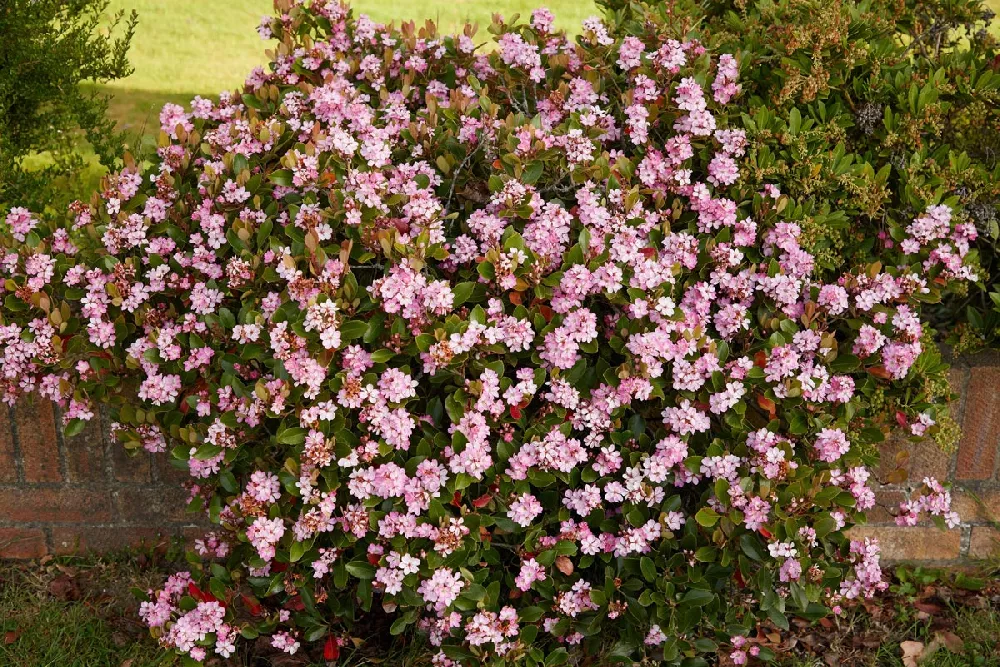- Home >
- Ornamental Plants >
- Pinkie Indian Hawthorn Shrub
Pinkie Indian Hawthorn Shrub for Sale - Buying & Growing Guide
- Ships in 1-2 days
- 1-Year Warranty Eligible
- Pots or accessories are not included unless specified in the product options.
Shipping Details:
Products shipped through FastGrowingTrees.com. Once your order is shipped, you’ll receive an email with a tracking number and estimated delivery date. Most orders will ship immediately.
Many plants may claim to offer ornamental value during all seasons, but few can live up to that promise as well as the Pinkie Indian hawthorn shrub. In spring, the fragrant blooms of this species, Rhaphiolepis indica 'Pinkie,' appear in pink and white. Later, small berries show brilliant shades that range from purple to blue. During the rest of the year, the Pinkie Indian hawthorn shrub makes itself known with its glossy evergreen leaves and its consistently neat and compact form.
- Its beautiful springtime flowers come in shades of pink and white.
- The Pinkie Indian hawthorn shrub grows to a compact mature size, making for easy maintenance.
- Its glossy evergreen leaves and purplish-blue fruits.
Plant Care
Sunlight

This shrub grows well in both full and partial sunlight.
Watering
Keep the soil moist by watering about once every week or once every two weeks.
Fertilizing

Fertilize about once per year or more if needed. Use a nitrogen-rich blend.
Planting and Care
Planting instructions
The Pinkie Indian hawthorn shrub is a plant that gives you some flexibility when choosing a growing location. When these plants have access to moist, well-draining soils, they can tolerate a relatively wide range of sun exposures. The compact nature of this cultivar also allows it to adapt incredibly well to container settings. Whether you grow your Pinkie Indian hawthorn in the ground or in a container, the soil should be slightly acidic, at about a pH of 6, and have a decent amount of organic nutrients present.
Watering and nutrients
Pinkie Indian hawthorn shrubs grow best in soils that are able to hold a certain amount of moisture while draining any excess effectively. Be sure to monitor the soil your plant grows in to ensure that it remains consistently moist most of the time. To ensure this is the case, you’ll want to water your Pinkie Indian hawthorn about once per week. Your Pinkie Indian hawthorn shrub will likely grow well with a single application of nitrogen-rich fertilizer. However, you can increase this rate if you wish. At times, you can provide feedings as often as monthly.
Pollination
Not only does the Pinkie Indian hawthorn shrub produce a lot of flowers, but each of those flowers also generates a lot of pollen. These plants are also known to be self-pollinating, as is common for most hawthorn species. Typically, the Pinkie Indian hawthorn shrub will attract insects to conduct pollination. Those pollinators include bees, wasps, and other flying insects. However, pollination should not be a concern, as achieving a harvest is not a common gardening goal for this plant.
Pruning
One major advantage of growing a Pinkie Indian hawthorn shrub is that these plants take on a pleasing shape without any help from pruning cuts. Without shaping, the pinkie Indian hawthorn will remain neat as it grows into a rounded and compact form. You may prune this plant to remove damaged branches and diseased parts or to thin the canopy. Any significant pruning you perform should take place after the bloom period has ended to ensure you do not remove any of the year’s flowers.
Pests, diseases, and animals
The greatest threat to a Pinkie Indian hawthorn shrub is the entomosporium leaf spot disease. This fungal infection is most common in moist and shady conditions that allow excessive moisture to stay on the leaves. When this infection arises in a Pinkie Indian hawthorn, it can cause most or all of the foliage to become discolored and deformed. There are a few other leaf-related diseases that can harm this plant. However, overall, there are not many notable pests that will damage your Pinkie Indian hawthorn.
Achieving maximum results
Be careful around the fruits of a Pinkie Indian hawthorn and all hawthorn varieties, for that matter. While the flesh of the fruits this plant produces is edible, the seeds are not. They contain high amounts of poison and are detrimental to those who accidentally consume them. So while the berries this plant grows are incredibly beautiful, you should do nothing more than look at them while preventing kids and pets from eating them.
FAQs
How large does a pinkie Indian hawthorn grow?
Are there other types of Indian hawthorn?
The Pinkie Indian hawthorn is one of many cultivars of the Indian hawthorn. The original species is known as Rhaphiolepis indica, or simply Indian hawthorn. Over the years, many different cultivated varieties have come into being, each of which has a unique name and has been bred to show specific physical traits and growth characteristics. For example, the Pinkie is a smaller variety that boasts pink blooms.
Can you keep an Indian hawthorn small?
You can keep an Indian hawthorn small with little to no effort at all. In fact, many varieties, including the Pinkie Indian hawthorn shrub, will remain small, at 3 feet or less, without pruning or sheering. However, you can keep your shrubs even smaller if you wish. The best way to do that is to use hand pruners to remove branches selectively rather than shearing off the outer edges of the plant, which often damages the foliage.
Compare Similar Products
Customer Reviews
 They were great
They were greatVery satisfied with service.
You can't add more Product Name - Product size to the cart.
OK







